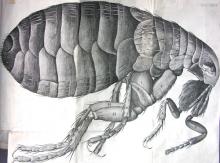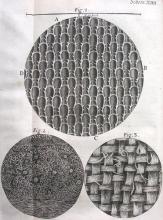Robert Hooke, Micrographia (London, 1665).
Hooke (1635-1702) made many contributions to 17th century science but Micrographia was his masterpiece. Although not the first publication of microscopical observations, it was the first great work devoted to them, and its impact rivaled that of Galileo's Sidereus nuncius half a century earlier. For the first time descriptions of microscopical observations were accompanied by profuse illustrations. Above all, the book suggested what the microscope could do for the biological sciences. Hooke's examination of the structure of cork led to his coining of the modern biological usage of the word 'cell'. In the animal realm he inaugurated the study of insect anatomy – his portraits of the flea and the louse are hardly less startling today than they must have been in the 17th century. His studies of microscopic fossils also led him to become one of the first proponents of a theory of evolution. The illustrations produced here show his study of a flea, and microscopical observations of the surfaces of several materials, including a leaf, mold and cloth.

